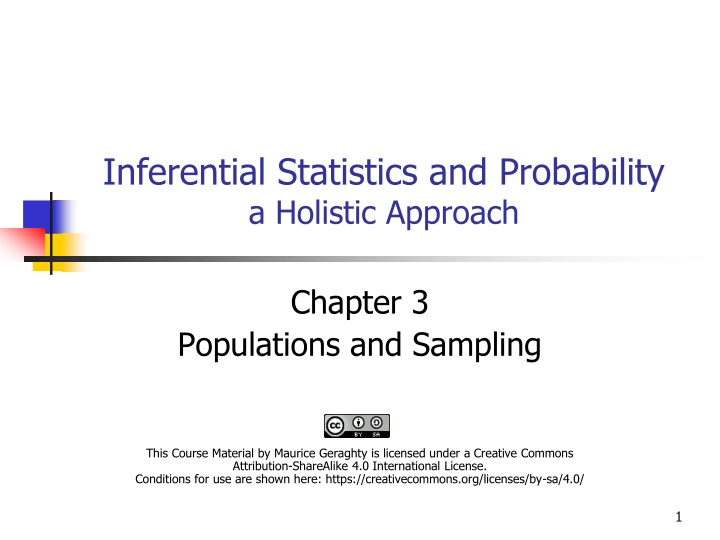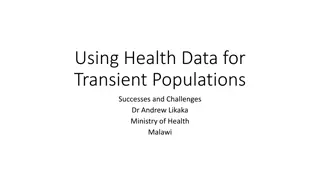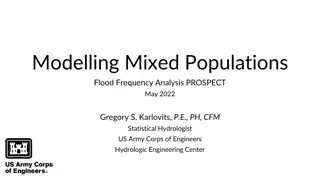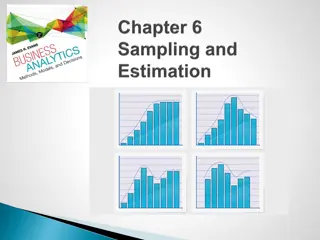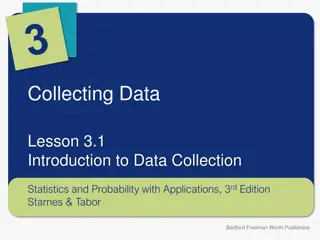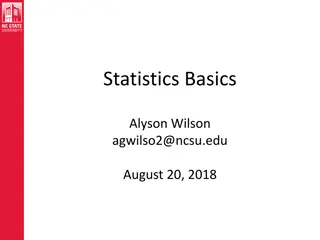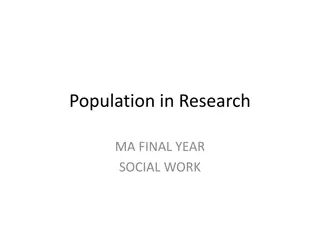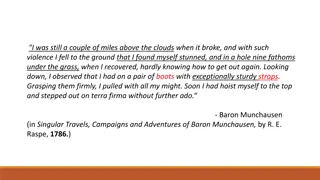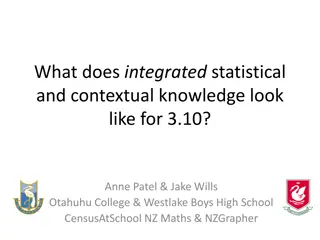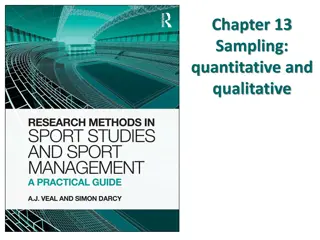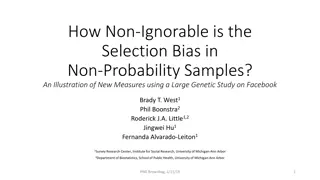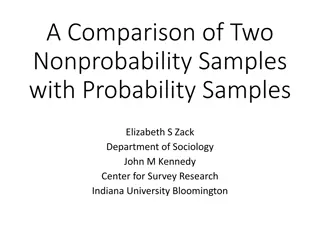Populations, Samples, and Statistical Studies
This material covers key concepts such as populations vs. samples, steps of a statistical process, representative samples, and observational studies with examples. It emphasizes understanding the differences between populations and samples, the importance of representative samples, and the methodologies of observational studies in statistical analysis.
Download Presentation

Please find below an Image/Link to download the presentation.
The content on the website is provided AS IS for your information and personal use only. It may not be sold, licensed, or shared on other websites without obtaining consent from the author.If you encounter any issues during the download, it is possible that the publisher has removed the file from their server.
You are allowed to download the files provided on this website for personal or commercial use, subject to the condition that they are used lawfully. All files are the property of their respective owners.
The content on the website is provided AS IS for your information and personal use only. It may not be sold, licensed, or shared on other websites without obtaining consent from the author.
E N D
Presentation Transcript
Inferential Statistics and Probability a Holistic Approach Chapter 3 Populations and Sampling Creative Commons License This Course Material by Maurice Geraghty is licensed under a Creative Commons Attribution-ShareAlike 4.0 International License. Conditions for use are shown here: https://creativecommons.org/licenses/by-sa/4.0/ 1
Population vs. Sample A population is the entire group of individuals or objects of interest to us. A sample is a subset of the population that we can study by collecting or gathering data. Quantities that describe populations are called parameters. Quantities that describe samples are called statistics. 2
Example A large community college has about 25,000 students. In a study of 85 students from college, it was determined that about 60 of the students have moderate or high math anxiety. The population is all the students at this college. The sample is the 85 students whose math anxiety was measured. 3
Steps of a Statistical Process Step 1 (Problem) Ask a question that can be answered with sample data. Step 2 (Plan) Determine what information is needed. Step 3 (Data) Collect sample data that is representative of the population. Step 4 (Analysis) Summarize, interpret and analyze the sample data. Step 5 (Conclusion) State the results and conclusion of the study. 4
Representative Sample A representative sample has characteristics, behaviors and attitudes similar to the population from which the sample is selected. A sample that is not representative is a biased sample. 5
Observational Study An observational study starts with selecting a representative sample from a population. The researcher then takes measurements from the sample, but does not manipulate any of the variables with treatments. The goal of an observational study is to interpret and analyze the measured variables, but it is not possible to show a cause and effect relationship. 6
Example of Observational Study Pew wanted to investigate a belief that American s use of online dating website and mobile apps had increased from a 2013 study, especially among younger adults. A survey was conducted among a national sample of 2,001 adults, 18 years of age or older using random digit dialing The survey found that in 2015, 15% of American adults have used online dating sites and mobile apps, compared to 11% in 2013. However, for young adults aged 18-24, the increase was dramatic: from 10% in 2013 to 27% in 2015. 7
Experiment An experiment starts with a representative sample from a population. The researcher will them randomly break this sample into groups and then apply treatments in order to manipulate a variable of interest. The goal of an experiment is to find a cause and effect relationship between a random variable in the population and the variable manipulated by the researcher. If an experiment is conducted properly, the researcher can control for confounding or lurking variables and test for a placebo effect. 9
Example of Experiment Researchers were studying gambling addiction by speed of play using electronic gaming machines. 62 participants played a computerized slot machine with either fast, medium, or slow play. Gambling speed had no overall effect on either mean bet size, game evaluations or illusion of control, but in the fast machines, at-risk gamblers employed higher bet sizes compared to no-risk gamblers. The findings corroborate and elaborate on previous studies and indicate that restrictions on gambling speed may serve as a harm reducing effort for at-risk gamblers. 10
Variables in an Experiment Explanatory Variable: The variable that is controlled or manipulated by the researcher. Response Variable: The variable which is being measured and is the focus of the study. The researcher tries to answer the question: "Does the explanatory variable (cause) affect the response variable (effect)? In the prior gambling example, the explanatory variable was the speed of the machine, and the response variable was the bet size. 11
Placebos and Blinding A placebo effect is when participant will respond in a positive way to a treatment with no active ingredients. This treatment with no active ingredients is called a placebo. A single blind study is where the participant does not know whether the treatment is real or a placebo. A double blind study is where neither the administrator of the treatment nor the participant knows whether the treatment is real or a placebo. 12
Example An researcher for a pharmaceutical company is conducting research on an experimental drug to reduce the pain from migraine headaches. Participants with migraine headaches are randomly split into 3 groups. The first group gets the experimental drug (Treatment Group). The second group gets a placebo, a fake drug (Placebo Group). The third group gets nothing (Control Group). The researcher found that pain was reduced for both the treatment group and the placebo group, establishing a placebo effect. The researcher must then compare the amount of pain reduction in the treatment group to the placebo group to determine if the treatment was effective. 13
Probability Sampling Methods Properly done, probability or scientific sampling will produce a representative sample. Simple Random Sampling Systematic Sampling Stratified Sampling Cluster Sampling 14
Example - Custom control searching Before leaving customs at several international airports, all passengers must push a button. If the button is red, you will be required to go through an intensive search. If the button is green, you will not be searched The button is totally random and has a 20% chance of being red. 16
Example Employee Drug Testing A shipping company has approximately 20,000 employees. The company decided to administer a random drug test to 5% of the employees, a sample size of 1000. The company has a list of all employees sorted by social security number. A random number is selected between 1 and 20. Starting with that person, every subsequent 20th person is also sampled. 18
Example Social Media Black Lives Matter Pew Research Center conducted a study to examine how people use social media such as Twitter or Facebook. The study focused on the content and hash tags used on people's comments about events involving racially motivated attacks by the police and differences in opinions about groups such as Black Lives Matter. Since the study involved people's opinions about race, it was important to use stratified sampling. Particular care was taken to make sure that there was appropriate representation in the sample from traditionally under-sampled African American and Latinx groups. 20
Example Sampling Students The De Anza College Data Science Club wanted to sample students to complete a survey Although the student records are confidential, the classes offered are available to anyone and can be easily sampled The club randomly sampled 100 classes offered during the Fall quarter (clusters), and asked the instructors to give the survey link to the students 22
Non-Probability Sampling Methods Non-probability sampling methods have immeasurable biases and will usually not produce a representative sample. Convenience Sampling Self-selected Sampling 23
Example Convenience Sample A 21 year old student wants to conduct a survey on marijuana usage. He asks his friends on Facebook to fill out a survey. The results of his survey show that 65% of respondents frequently use marijuana. The student's Facebook friends were easy to sample but are not representative of the population. For example, if the student frequently uses marijuana, it is more likely that his Facebook friends would also use marijuana 24
Example Self-Selected Sample Online rating services, such as Google, Yelp, Rotten Tomatoes, IMDb and Rate My Professors are examples of self-selected sampling Users volunteer to write reviews. This can lead to ratings that may be extremely inaccurate. Al Gore's "An Inconvenient Sequel: Truth to Power" was released as a follow-up to his original documentary about climate change The IMDb rating in this case was not a true movie rating but an attempt to discredit or to support climate change. 25
Sources of Bias in Sampling Selection bias when the sampling method does not produce a representative sample. Self-selection bias when participants who volunteer are not representative of the population. Non-response bias when people are intentionally or non-intentionally excluded from participation or choose not to participate in a survey or poll. Response bias when the wording of the questions in surveys affect the response. 26
Example Non-response bias In 2020 presidential polls understated Trump s Support by about 3.3 percentage points on average, while overstating Biden's support by about 1 point This mirrors the polling error in 2016, where Trump s support was also underestimated Less educated voters who were a key demographic for Trump on Election Day are consistently hard for pollsters to reach The Rust Belt which includes Wisconsin, Michigan and Pennsylvania is notoriously difficult to survey and has many under-sampled Trump supporters 27
Example Response Bias Consider these questions: Do you feel that the increasing cost of the high speed rail project is too expensive for California? Do you feel that high speed rail will be important to the future economy of California? Do you approve or disapprove of building a high speed rail system in California? The first question encourages people to oppose high speed rail because of the expense. The second question encourages people to support high speed rail to support the economy. The third question simply asks people s opinion without the leading bias. 28
